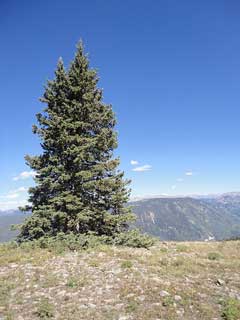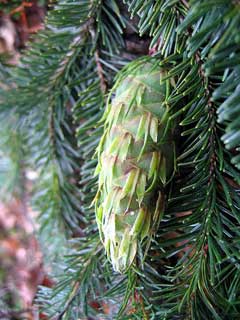 |
|
http://www.flickr.com/photos/53301297@N00 |
 |
| http://commons.wikimedia.org/wiki/User:Nova |
Translate this page:
Summary
Bloom Color: Red. The tree is a conical, evergreen conifer with long whorled branches and drooping twigs. The gray bark is usually deeply furrowed. The petioled needles are flat, grooved, dark green above, lighter green below, and usually spreading all around the stem like the bristles of a bottle brush. The small cone has characteristic 3-tongued scales. Form: Pyramidal.
Physical Characteristics

 Pseudotsuga menziesii is an evergreen Tree growing to 75 m (246ft) by 20 m (65ft) at a fast rate.
Pseudotsuga menziesii is an evergreen Tree growing to 75 m (246ft) by 20 m (65ft) at a fast rate.
See above for USDA hardiness. It is hardy to UK zone 7 and is not frost tender. It is in leaf all year, in flower from March to May, and the seeds ripen from September to November. The species is monoecious (individual flowers are either male or female, but both sexes can be found on the same plant) and is pollinated by Wind.
Suitable for: light (sandy), medium (loamy) and heavy (clay) soils. Suitable pH: mildly acid and neutral soils. It cannot grow in the shade. It prefers moist or wet soil. The plant can tolerates strong winds but not maritime exposure.
UK Hardiness Map
US Hardiness Map
Synonyms
P. douglasii. P. mucronata. P. taxifolia. Abies douglasii. A. taxifolia. Pinus taxifolia.
Plant Habitats
Woodland Garden Canopy; Bog Garden;
Edible Uses
Edible Parts: Inner bark Manna Shoots
Edible Uses: Coffee Condiment Gum Tea
Young shoot tips - used as a flavouring in cooked foods[15, 177]. A subtle woodsy flavour[183]. A refreshing tea is made from the young leaves and twigs[14, 46, 177, 257]. Rich in vitamin C[183]. It is used as a coffee substitute according to some reports[92, 95, 161, 257]. The fresh leaves have a pleasant balsamic odour and are used as a coffee substitute[213]. Inner bark - dried, ground into a meal and mixed with cereals for making bread etc[161, 213]. A famine food used when all else fails[177]. A sweet manna-like substance is exuded from the bark[177, 183]. This report possibly refers to the resin that is obtained from the trunk[K], and is used as a chewing gum by various native North American Indian tribes[226]. Alternatively, the report could be referring to the sap which is used as a sugar-like food[257].
References More on Edible Uses
Medicinal Uses
Plants For A Future can not take any responsibility for any adverse effects from the use of plants. Always seek advice from a professional before using a plant medicinally.
Antirheumatic Antiseptic Kidney Mouthwash Poultice Skin Vitamin C
Douglas fir was often employed medicinally by various native North American Indian tribes who used it to treat a variety of complaints[257]. It is little, if at all, used in modern herbalism. An antiseptic resin is obtained from the trunk. It is used as a poultice to treat cuts, burns, wounds and other skin ailments[226, 257]. The poultice is also used to treat injured or dislocated bones[257]. The resin is used in the treatment of coughs and can be chewed as a treatment for sore throats[257]. An infusion of the green bark has been used in the treatment of excessive menstruation, bleeding bowels and stomach problems[257]. An infusion of the leaves has been used as a wash and a sweat bath for rheumatic and paralyzed joints[257]. An infusion of the young sprouts has been used in the treatment of colds[257]. An infusion of the twigs or shoots has been used in the treatment of kidney and bladder problems[257]. A decoction of the buds has been used in the treatment of venereal disease[257]. Young shoots have been placed in the tips of shoes to keep the feet from perspiring and to prevent athletes foot[257]. A mouthwash is made by soaking the shoots in cold water[15].
References More on Medicinal Uses
The Bookshop: Edible Plant Books
Our Latest books on Perennial Plants For Food Forests and Permaculture Gardens in paperback or digital formats.

Edible Tropical Plants
Food Forest Plants for Hotter Conditions: 250+ Plants For Tropical Food Forests & Permaculture Gardens.
More

Edible Temperate Plants
Plants for Your Food Forest: 500 Plants for Temperate Food Forests & Permaculture Gardens.
More

More Books
PFAF have eight books available in paperback and digital formats. Browse the shop for more information.
Shop Now
Other Uses
Basketry Cork Dye Fertilizer Fuel Gum Insecticide Resin Shelterbelt Tannin Wood
A light brown dye is obtained from the bark[118, 257]. The bark is a source of tannins[46, 82]. The bark can be used as a cork substitute[171] and is also used to make fertilizer[226]. The bark contains pitch, it burns with a lot of heat and almost no smoke, so it is prized as a fuel[226, 257]. The small roots have been used to make baskets[257]. The plant has insecticidal properties[171]. A resin is obtained from the trunk, similar to Abies balsamea[61, 64] which is used in the manufacture of glues, candles, as a cement for microscopes and slides and also as a fixative in soaps and perfumery[171]. The resin can also be used as a caulking material on boats[257]. A fast growing and fairly wind-resistant tree, it is often used in shelterbelt plantings[185]. Wood - heavy, strong, fine grained, durable, though it can be of variable quality. It dries quickly, does not warp and is easily worked, it is used for heavy construction, telegraph poles, furniture etc[21, 46, 61, 82, 99, 171, 200, 226]. It is also used as a good quality fuel[46, 99, 257].
Special Uses
Food Forest Scented Plants
References More on Other Uses
Cultivation details
Landscape Uses:Christmas tree, Firewood, Aggressive surface roots possible, Screen, Specimen. Prefers a moist but not water-logged alluvial soil[1]. Dislikes calcareous soils[1]. Trees are a failure on dry hungry soils.[11]. Whilst they are moderately wind resistant[166], tall specimens are likely to lose their crowns once they are more than 30 metres tall in all but the most sheltered areas[185]. A very ornamental tree[1], it is the most cultivated timber tree in the world and is extensively used for re-afforestation in Britain[200]. There are several named varieties selected for their ornamental value[188]. Trees can be established in light shade but this must be removed in the first few years or growth will suffer[185]. Very slow growing for its first few years, growth soon becomes extremely fast with new shoots of up to 1.2 metres a year[185]. This annual increase can be maintained for many years[185]. Trees in sheltered Scottish valleys have reached 55 metres in 100 years[200]. New growth takes place from May to July[185]. The trees require abundant rainfall for good growth[11, 49]. Trees should be planted into their permanent positions when they are quite small, between 30 and 90cm. Larger trees will check badly and hardly put on any growth for several years. This also badly affects root development and wind resistance[200]. Trees are very long-lived, specimens over 1,000 years old are known[226]. Seed production commences when trees are about 10 years old, though good production takes another 15 - 20 years[229]. Good crops are produced about every 6 years[229]. This tree is a pioneer species because it cannot reproduce under its own canopy[226]. The bark on mature trees can be 30cm thick, and this insulates the trunks from the heat of forest fires[213]. This species is notably resistant to honey fungus[81, 200]. Young growth can be damaged by late frosts[81]. The leaves have a strong sweet fruity aroma[185]. Special Features:
North American native, Inconspicuous flowers or blooms.
References Carbon Farming Information and Carbon Sequestration Information
Temperature Converter
Type a value in the Celsius field to convert the value to Fahrenheit:
Fahrenheit:
The PFAF Bookshop
Plants For A Future have a number of books available in paperback and digital form. Book titles include Edible Plants, Edible Perennials, Edible Trees,Edible Shrubs, Woodland Gardening, and Temperate Food Forest Plants. Our new book is Food Forest Plants For Hotter Conditions (Tropical and Sub-Tropical).
Shop Now
Plant Propagation
Seed - best sown in the autumn to winter in a cold frame so that it is stratified[80]. The seed can also be stored dry and sown in late winter. When they are large enough to handle, prick the seedlings out into individual pots and grow them on in light shade in the cold frame for at least their first winter. Plant them out into their permanent positions in late spring or early summer, after the last expected frosts. Seedlings tolerate light shade for their first few years of growth. Cones often fall from the tree with their seed still inside[80]. If you have plenty of seed then it can be sown in an outdoor seedbed in early spring[80]. Grow the plants on for at least two years in the seedbed before planting them out in late autumn or early spring.
Other Names
If available other names are mentioned here
Native Range
NORTHERN AMERICA: Canada (Alberta (southwest), British Columbia), United States (Colorado, Idaho, Montana, Oregon, Washington, Wyoming, New Mexico, Texas, Arizona, California, Nevada, Utah), Mexico (Chihuahua, Coahuila de Zaragoza, Durango, Nuevo León, San Luis Potosí, Sinaloa, Sonora, Tamaulipas, Zacatecas, Guerrero, Hidalgo, México, Oaxaca, Puebla, Querétaro, Tlaxcala, Veracruz de Ignacio de la Llave)
Weed Potential
Right plant wrong place. We are currently updating this section.
Please note that a plant may be invasive in one area but may not in your area so it's worth checking.
Conservation Status
IUCN Red List of Threatened Plants Status :

Growth: S = slow M = medium F = fast. Soil: L = light (sandy) M = medium H = heavy (clay). pH: A = acid N = neutral B = basic (alkaline). Shade: F = full shade S = semi-shade N = no shade. Moisture: D = dry M = Moist We = wet Wa = water.
Now available:
Food Forest Plants for Mediterranean Conditions
350+ Perennial Plants For Mediterranean and Drier Food Forests and Permaculture Gardens.
[Paperback and eBook]
This is the third in Plants For A Future's series of plant guides for food forests tailored to
specific climate zones. Following volumes on temperate and tropical ecosystems, this book focuses
on species suited to Mediterranean conditions—regions with hot, dry summers and cool, wet winters,
often facing the added challenge of climate change.
Read More
Expert comment
Author
(Mirb.)Franko.
Botanical References
1160200
Links / References
For a list of references used on this page please go here
Readers comment
© 2010, Plants For A Future. Plants For A Future is a charitable company limited by guarantee, registered in England and Wales. Charity No. 1057719, Company No. 3204567.